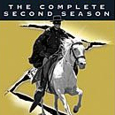Walt Disney Productions (1955-1959), Walt Disney Home Entertainment (May 18, 2004), 2 disc box set, 240 mins plus supplements, 1.33:1 original full frame ratio, Dolby Digital Mono, Not Rated, Retail: $32.99
Storyboard:
No one can argue against the fact that Walt Disney was a visionary. Walt was always trying new things, experimenting with new ideas, and was always looking to the future. However, Walt never pretended to know everything, and he even said, “We don’t pretend to be scientists. We’re storytellers.” This was mirrored in the inclusion of Tomorrowland in his Disneyland theme park, where he created a place for guests to experience the wonders of the future. Tomorrowland also became a segment on his Disneyland television show. One of the first series presented on the Tomorrowland segment of the show was Man in Space. At first, Disney wanted to create one large show about man and his relationship to space. He quickly ordered his artists and animators to come up with some ideas for the show. Veteran director Ward Kimball was placed at the helm of this project, bringing his own sense of humor and wit to the segments. Soon, the amount of art was so large that Disney and Kimball felt that three different shows could be made, and thus the Man in Space series was expanded. The Tomorrowland segment was also the place where Disney explored new technological achievements such as nuclear energy and his vision for the future.
The Sweatbox Review:
Sputnik’s launch by the Soviet Union in 1957 represented the beginning of an era in space exploration. Over the centuries, man had become fascinated with the skies, with its countless stars and planets. Walt Disney was no different, and he became fascinated with space exploration and what the future holds for mankind. Some have even credited Walt Disney’s vision, which he showcased on his Disneyland TV show, for making the early Space Program popular among the masses. His series of programs and shorts regarding space exploration and technology were so successful that they became educational tools in schools around the country. President Eisenhower even requested a copy of one of his shows to show the Pentagon, and his model Space Station today sits in the Air and Space Museum in Washington, DC. It was only a few short years later that the Space Race between the US and the USSR reached its peak with the launch of the first man into space, and later the moon.
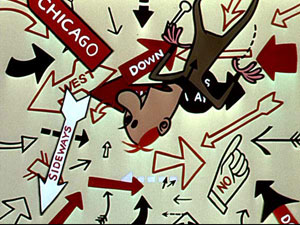
Many have called Disney the eternal optimist, and in an era of scientific discovery, he became, what Leonard Maltin likes to call, the optimistic futurist. Disney loved innovation and was fascinated by what the future would bring. From his early days experimenting with sound for animated pictures, and throughout his fascination with animatronics for his Disneyland theme park and the New York World Fair, Disney was always interested in cutting-edge technologies. I loved watching these shows, because Walt’s enthusiasm really comes through and he is always excited about the future. This can be best exemplified by his enthusiastic presentation of his original vision for EPCOT, part of his Florida project. Even when talking about something as simple as the atom, Disney exemplified optimism in what he hoped would be something that could help humanity. Now, all of these shows are collected on this two-disc set, part of the Walt Disney Treasures series.
The set is divided into two discs, with the first disc featuring the three Man in Space series shown on the Tomorrowland segment of the Disneyland TV show. There are insightful Maltin introductions at the beginning of both discs. Leonard Maltin also introduces each of these segments revealing some interesting facts about them. These episodes were originally broadcast in black and white, although filmed in color. The episodes here are mostly in color, with the exception of opening and closing credits. Episodes are usually about 50 minutes long. The second disc contains a theatrical featurette about satellites, an educational show about the atom, and Disney’s promotional EPCOT video. The bonus features are also in the second disc.

The first Tomorrowland episode debuted on March 9, 1955 and it was Man in Space. Disney had originally asked for one full episode about what space travel would be like, but there were so many ideas and artwork that these were later used in other shows. These shows were directed by legendary director/animator Ward Kimball who had worked on several animated features for the company. The show was so successful that Disney later released a shorter version of the show as a featurette accompanying Davy Crocket and the River Pirates in theatres. It landed an Academy Award nomination in the following year. The show starts out with Ward Kimball explaining the history of Rockets from ancient China to modern experiments in the United States. He explains Newton’s Third Law of Motion about how every action has an equal and opposite reaction. Most of these segments are animated with some live action and still footage is used as well. Several scientists, including Werner von Braun (who today is regarded as the father of the United States Space Program), explain how a rocket will be able to fly into space. The highlight of the show is an animated sequence where a doctor talks about the effects of space travel on man. It is a hilarious segment with many visual puns as the narrator talks about the trials and tribulations. The show ends with a beautifully animated, although slightly slow, sequence illustrating how many people will reach space, and then return.
Man and the Moon debuted on December 28, 1955 (later rerun as Tomorrow: The Moon). Disney had already introduced people to a trip to the moon on his Disneyland theme park simulation. Now, with Ward Kimball and his team, the show wanted to explore man’s relationship to the moon, and how we could potentially reach it. Once again, the show explores man’s relationship to the moon through history. They explore references to the moon in literature, nursery rhymes, and songs (including a parody of “Ah, See the Moon”). Von Braum returns and talks about a future space station, and how we would need it to get to the moon. This is done with some beautiful still pictures and artwork. The show ends with a live-action reenactment on how we will get to the moon. It actually manages to be really suspenseful and interesting, although we can clearly see the wires trying to depict weightlessness. This show is more entertaining than the first, and I actually learned quite a bit about space travel. It clearly depicts Disney’s ability to educate and entertain at the same time. Disney completists will be thrilled to know that at the end of the episode Disney introduces next week’s Fantasyland episode of “When Knighthood was in Flower”, and then a preview of the Littlest Outlaw shows after the credits.

The most entertaining and most expensive of the Man in Space series was Mars and Beyond. It debuted on television on December 4th, 1957, and was later released theatrically on the 25th of the same month. This was a new era for space exploration since Sputnik was released just a few months prior. Walt Disney, accompanied by a robot named Garco, introduces the show. Once again, it begins with an animated history of man’s relationship to space and the stars, from cave dwellers to modern man. This segment is hilarious and features many of Kimball’s visual puns and gags. There is a great segment about what sci-fi films and they even parody the average plot. I laughed out loud when one of the aliens chasing a woman happened to be Donald Duck. Following this segment is one explaining how life evolved on Earth, and it features some beautiful abstract animation art. They also speculate about life on Mars, with some fantastic creatures, and on how to get there. Some of this animation in this show blew my mind away, not only because of how good it was, but because it is so un-like most Disney animation. It is modern, cutting-edge, and very witty, and sometimes reminded me of the UPA cartoons of the 1950s. At the end, Disney introduces a new Frontierland episode of “The Horse of the West”, and there is a quick preview of Old Yeller during and after the closing credits.
Eyes in Outer Space originated in theaters as a half-hour featurette in June of 1959 and was later shown on the Disneyland TV show. By this point, several satellites had been launched and Sputnik became the first man-made object in space in 1957. The show begins by talking about how these satellites will be used to understand the great forces of nature and predict weather. The first segment talks about how weather can affect our personality, and how we have tried to predict weather over the years using superstitions. It features exciting animation with jazz music showing how weather is linked to the Earth’s water cycle. Using their imagination, they talk about how weather satellites will be launched changing the face of weather prediction in the future. They do this through a live-action re-enactment of a fictitious worldwide weather center of the future. In this segment, man uses rocket technology to control the path of a hurricane from this center. I have to admit this last segment was kind of disturbing, but it reflects how people back then believed technology would give them the power to do positive things (even if by today’s standards, they might not be positive).
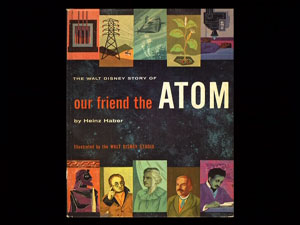
This belief in the positive potential of technology is most prevalent in Our Friend, the Atom which aired on January 23rd, 1957. The episode is narrated by scientist Heinz Haber, who also wrote a book that accompanied the show. In this episode, he looks at the positive potentials of nuclear energy, and attempts to explain the power of atomic energy. The episode compares the power of the atom to a genie, a comparison that can only be explained by watching the episode. Haber narrates the history of the atom and what man believed about matter, beginning once again with Ancient Greece. Haber is an effective host, and he uses some great illustrations to get his point across. When explaining a nuclear chain reaction, he uses ping pong balls on a table filled with mouse traps. One of the things that made me cringe during the show is how Haber just holds uranium in his hands and how they believed it would be good for people’s health (radiation). Of course, this show was made before people understood the negative effects of nuclear radiation. Still, it is an interesting show and it successfully explains how atoms work. At the end, there’s a preview for Westward Ho! The Wagons.

Walt Disney’s last public appearance was in October of 1966 (he died two months later) on a half-hour promotional video for his plans for his Florida project, EPCOT. According to Maltin, this is the first time that the video is shown to the general public, since it was made for Florida legislators and companies involved in the project. It begins with images of Disneyland and talks about how Disney has always wanted to make his parks great for everyone. Then Walt takes over to explain the Florida project, which he calls the “Project of Tomorrow”. He shows a huge map, and points out that the theme park is only a small part of the project (a total of 27,400 acres). Walt shows his plans for an airport of the future, with a welcome area, an industrial park, and a theme park area in the north. To Walt, the heart of project is his “Experimental Prototype Community Of Tomorrow” (EPCOT). The purpose of this project is to find solutions to the problems of the cities. The plans for Walt’s city are amazing, and he plans to house 20,000 citizens who will work in the city, the industrial park, and in the theme parks. There are many innovations in the city, including a climate-controlled environment with ideal weather conditions, effective transportation, and modern installations. While EPCOT was never built to Walt’s specifications, it did become a showcase as a theme park for new technology and the future.

Is This Thing Loaded?
For this two-disc set, there are two great interviews, and a large picture gallery filled with artwork from the television episodes and theatrical featurettes.
The first one of these features is The Optimistic Futurist: An Interview with Ray Bradbury (24:40). Here, Maltin interviews renowned science fiction author Ray Bradbury (Martian Chronicles, Fahrenheit 451) about the first time he met Walt Disney and how they became friends. Bradbury provides some interesting anecdotes about Walt and his vision for the future. He calls Walt an optimal behaviorist, and explains that he believed in people doing good everyday. They also discuss about how Disney helped the US government in selling the idea of space travel to the public. They talk about their involvement at the New York World Fair, and how they were sad that it had to be torn down. There was one comment that stuck with me and shed some more light into Walt’s vision of EPCOT. According to Bradbury, Walt believed that by building EPCOT, they would have a permanent world’s fair that wouldn’t get destroyed. Overall, it is a great and interesting interview with one of the world’s most creative minds.

The second interview is Marty Sklar, Walt, and EPCOT (26:33), where Maltin talks to the man who wrote many of Walt’s introductions and who has worked with Disney Imagineering since 1955. He explains that Walt wanted people to experience the future just like at the World Fair, and that this was Tomorrowland to him. He gives some information about the first Tomorrowland and Walt’s future plans for the park. He highlights Disney’s job at the World Fair, and how many of the projects ended up at EPCOT, including the Carrousel of Progress showing man’s progression through history. This is another exciting interview, and Sklar’s even comments on how the project ended up looking like today’s futuristic theme park.
There are also many galleries on the second disc with over one hundred pictures (I counted 149). First up is a Publicity Gallery featuring newspaper advertisements for the theatrical featurettes and covers to books and comic books. There are also book jacket introductions which can be read with a zoom button. The Behind the Scenes Gallery features photos of Ward Kimball, the scientists, artists, and advisors who worked on many of these projects. Finally, there are Story and Background Art Galleries for Man in Space, Mars and Beyond, and Man and the Moon. These show the concept art, story sketches, and even storyboards for the shows. As Maltin explains it, Walt spent more money on these than the average television show. Maltin provides audio commentary for several of the pictures.
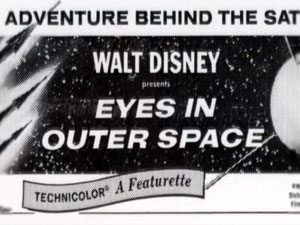
Click right on the Main Menu button of the Bonus Features on the 2nd disc and it will highlight a red button (next to the Register Your DVD writing). Click on this to watch the taping of a pitch to GE. It features Walt and the Sherman Brothers singing “There’s a Great Big Beautiful Tomorrow” which was going to be shown at the GE pavilion at the New York World Fair. It is a great pitch with some artwork and Walt’s vision for the exhibit. This is when the Carousel of Progress is used (to show how electricity changed life).
Case Study:
In line with previous releases in the Walt Disney Treasures line, Tomorrowland: Disney in Space and Beyond comes in thick double keepcase that is inside a limited edition tin (105,000 were produced). Inside, we find a lithograph print of the poster for the Space Station X-1 ride from Disneyland, as well as an eight-page booklet, which provides an outline for the set as well as some comments from Leonard Maltin.
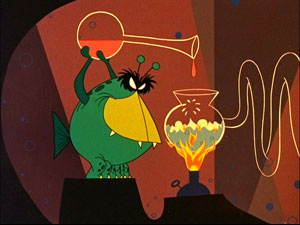
Ink And Paint:
All of the episodes were filmed and are provided in their original 1.33:1 full frame television aspect ratio. While the episodes do contain a moderate amount of grain, they look like they have undergone some cleanup. The image is usually quite clear with many colorful live-action and animated segments. Sometimes, the dust was visible, particularly in some black and white segments, but this did not distract me from enjoying these great shows. There are approximately four hours of material spread across the two discs and it is worth watching every minute.
Scratch Tracks:
The audio tracks for all of these episodes, as well as the Maltin segments, are featured only in English Dolby Digital 2.0 tracks. The show sounds just like we expect a fifty-year-old television episode to sound. The tracks used are good with no problems, and there is no need for these to be any better. Most of the segments are narrated with the only other noises coming from the musical score of the programs. The highlight for me, sound-wise, was the jazz music that played in a segment of Mars and Beyond. English subtitles are also provided for the hearing impaired.

Final Cut:
While I was initially hesitant about what this set had to offer, I was completely blown away by how great it was. Maltin continues to surprise with these Walt Disney Treasures, and this one does not disappoint. I was always a fan of the educational films Disney made because they were entertaining and educational at the same time. There are some great Tomorrowland episodes on these two discs, and they really reflect how Disney felt about the future and his optimism towards it. Ward Kimball directs some great episodes about space travel, and it is interesting to see how many of the predictions came true. Watching this show, I became more aware about how Walt Disney was such a visionary. His enthusiasm and energy comes through, and makes the experience enjoyable. It is great to finally have his vision for the future on such a great set.
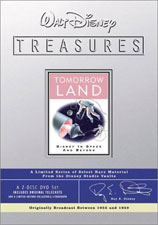 | ||
 |









